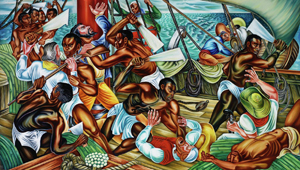Hale Woodruff facts for kids
Quick facts for kids
Hale Aspacio Woodruff
|
|
|---|---|

Hale Woodruff in studio
|
|
| Born | August 26, 1900 Cairo, Illinois
|
| Died | September 6, 1980 (aged 80) New York, New York
|
| Nationality | American |
| Education | Herron School of Art, Chicago Institute of Art, Harvard's Fogg Art Museum, Académie Moderne, Académie Scandinave Maison Watteau |
| Known for | Painting, Murals |
|
Notable work
|
Amistad Mutiny murals (1938–1942) |
| Spouse(s) | Theresa Ada Baker |
Hale Aspacio Woodruff (born August 26, 1900 – died September 6, 1980) was an important American artist. He was famous for his amazing murals (large wall paintings), other paintings, and prints.
Early Life and Learning
Hale Woodruff was born in Cairo, Illinois, in 1900. He grew up in Nashville, Tennessee, where he went to schools that were only for black students at the time. He loved art and studied at several schools, including the Herron School of Art and Design in Indianapolis and the Art Institute of Chicago. He also studied at the Harvard Fogg Art Museum.
In 1926, Woodruff won a special award from the Harmon Foundation. This award allowed him to live and study in Paris, France, for four important years (1927–1931). In Paris, he learned at art schools like the Académie Scandinave and the Académie Moderne. He also spent a lot of time in the city's museums, learning from the great artworks there. He met other American artists living in Paris, like Henry Ossawa Tanner. Woodruff also started collecting African art, which inspired many modern artists, including Pablo Picasso.
He came back to the U.S. in 1931 and married Theresa Ada Baker. They had one son named Roy.
Artistic Journey
Woodruff had to return to the U.S. because of money problems during the Great Depression. He became an art teacher to support his family. Later, he became the art director at Clark Atlanta University, which was a special college for black students. He taught art classes to students there. He also started an art competition called Atlanta University Annual Exhibition of Paintings, Sculpture, and Prints by Negro Artists. This show helped many African-American artists share their work from 1942 to 1970.
In 1936, Woodruff traveled to Mexico to learn from the famous mural painter Diego Rivera. He learned how to paint large frescoes (wall paintings) and how to show people in his art. After this, he returned to Atlanta and kept teaching. He also started going to Talladega College in Alabama to teach and create a series of murals there.
After coming back to the United States, Woodruff used what he learned about Post-Impressionism and Cubism in his paintings and prints. He wanted his art to speak out against the racism and poverty that African Americans faced in the South during the Great Depression.
During the 1950s, Woodruff had three solo art shows at the Bertha Schaefer Gallery.
One of Woodruff's most famous works is a set of three murals called the Amistad Mutiny murals (1938). He painted these for the Savery Library at Talladega College. The murals show the story of the 1839 Mende slave revolt on the Spanish ship Amistad. Even though the slave trade was banned by the U.S. and Britain, Spain was still taking people from Africa as slaves. The murals show the captives fighting back on the ship, their trial in the U.S. Supreme Court, and the Mende people finally returning to Africa.
At Talladega College, there's a picture of the Amistad ship on the lobby floor of the library. It's a tradition not to walk on it, even though it's in the middle of the floor! The library also has another set of three murals by Woodruff. These show important moments in the history of black colleges, like former slaves enrolling after the American Civil War.
Woodruff also created other important murals. He worked with Charles Alston on The Negro in California History (1949) for an insurance company in Los Angeles. He also completed six panels called Art of the Negro (1951) at the Clark Atlanta University Art Galleries.
In 1942, Woodruff started the Atlanta University Art Annuals. These were national art shows and competitions that continued until 1970. They were very important for black artists to show their work.
In 1946, Woodruff became a teacher at New York University in Manhattan. He taught there for over 20 years, retiring in 1968. Many students learned from him, including Malkia Roberts.
Hale Woodruff passed away in New York City on September 6, 1980.
Exhibitions and Legacy
Hale Woodruff's art has been shown in many places. He had a solo exhibition called Ancestral Memory at the Studio Museum in Harlem in 1976. His work was also part of big group shows like Two Centuries of Black Art at the Los Angeles County Museum of Art in 1976.
In 2012, the High Museum of Art in Atlanta, Georgia, organized a special exhibition of Woodruff's murals from Talladega College. These restored murals traveled around the United States. They were shown at places like the African American Museum (Dallas), the Birmingham Museum of Art, and the National Museum of African American History and Culture. This helped many more people see and appreciate his important artworks.


